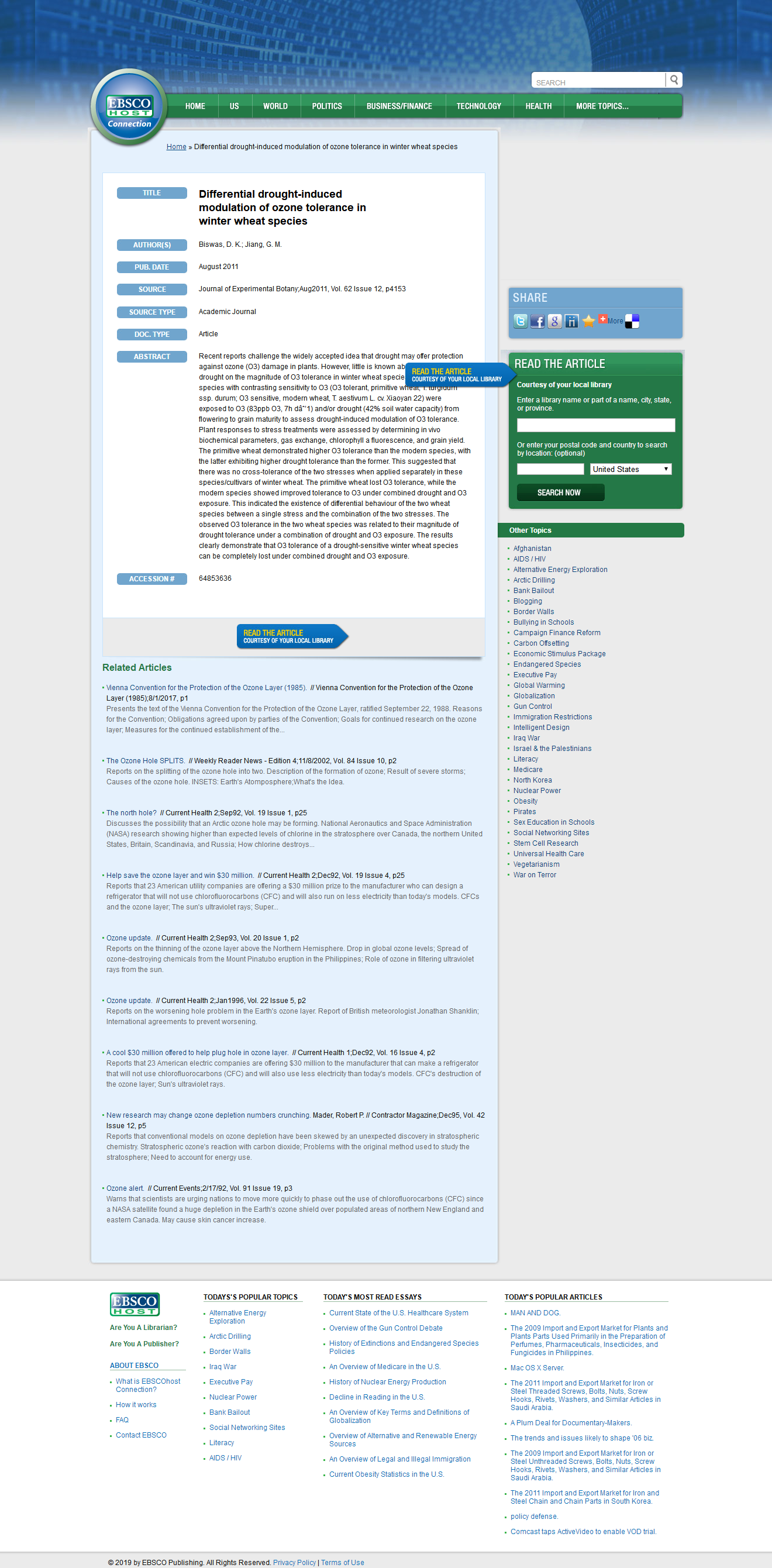博文
臭氧诱导的冬小麦品种抗旱可塑性种间差异研究
|||
臭氧诱导的冬小麦品种抗旱可塑性种间差异研究
毕斯沃斯、蒋高明*
*通讯作者
中国科学院植物研究所植被与环境变化国家重点实验室,北京香山南辛村20号 100093
中国科学院大学资源与环境学院,北京玉泉路 19号,100049
实验植物学报,2011, 62(2): 1-10 (影响因子 5.345)
【摘要】 最近报道指出,干旱可以保护植物免受臭氧(O3)破坏,该观点挑战了人们对于臭氧胁迫下植物抗干旱能力的认识。然而,干旱对冬小麦品种耐O3能力的影响却鲜为人知。本研究比较了两个冬小麦品种对O3(耐O3,原始小麦,T. turgidum;小偃22号,O3敏感,现代品种)臭氧敏感性。从开花到籽粒成熟期间,将实验材料暴露于O3(83ppb O3,7h-d'1)和/或干旱(42%土壤含水量)中,以评估干旱诱导的O3耐性调节。通过测定体内生化参数、气体交换、叶绿素a荧光和籽粒产量来评估不同品种小麦对臭氧与干旱胁迫的响应。原始品种比现代品种表现出更高的耐O3性,现代品种表现出更高的耐旱性。这表明,这两种胁迫单独应用于冬小麦品种时,不存在交叉耐受性。原始小麦对O3耐性丧失,而现代品种在干旱和O3联合作用下对O3耐性提高。这表明两种小麦在单种胁迫和两种胁迫的组合之间存在差异行为。两种小麦在干旱和O3胁迫下的耐旱性与其耐旱程度有关。结果表明,在干旱和O3共同作用下,对干旱敏感的冬小麦品种的耐O3能力完全丧失。
上述观点引起了国外同行的关注。英国兰卡夏大学(University of Lancaster) Sally Wikinson 等人的综述文章《How is ozone pollution reducing our food supply》(臭氧污染怎样减少我们的食物供应)引用了我们论文的大部分内容,包括introduction, mechanisms for ozone induced yield loss, basis for genotypic sensitivity to ozone, changes in stomatal conductance, changes in photosynthetic capacity, ozone by environment interactions sections 等。
Sally Wikinson博士是兰卡夏大学环境研究中心的Senior Research Associate,长期从事臭氧污染与作物生理生态响应研究。她的综述文章在Journal of Experimental Botany第10期,当年投稿当年发表。说明我们进行的臭氧对作物产量影响的文章获得国外同行高度关注。
我们文章第一作者为Dilip Kumer Biwas,他是植物所第一个全程培养的外国留学生,毕业后附加拿大做博士后研究。他在笔者课题组从事博士论文研究期间发表IF>5文章4篇(含一篇IF 8.88),是目前为止笔者最得意的毕业生之一。
英国学者引用我们团队文章及其作者背景情况链接如下:
http://jxb.oxfordjournals.org/content/early/2011/10/17/jxb.err317.full
http://www.lec.lancs.ac.uk/people/Sally_Wilkinson
Differential drought induced modulations of ozone tolerance in winter wheat species
Biswas DK & Jiang Gaoming*
*Correspondence author
State Key Laboratory of Vegetation and Environment Change, Institute of Botany, the Chinese Academy of Sciences, 20 Nanxincun, Xiangshan, Beijing 100093, China
College of Resources and Environment, University of Chinese Academy of Sciences, 19 Yuquan Avenue, Beijing 100049, China
Journal of Experimental Botany, 62(2): 1-10(IF=5.345)
Abstract: Recent reports challenge the widely accepted idea that drought may offer protection against ozone (O3) damage in plants. However, little is known about the impact of drought on the magnitude of O3 tolerance in winter wheat species. Two winter wheat species with contrasting sensitivity to O3 (O3 tolerant, primitive wheat, T. turgidum ssp. durum; O3 sensitive, modern wheat, T. aestivum L. cv. Xiaoyan 22) were exposed to O3 (83ppb O3, 7h daˆ’1) and/or drought (42% soil water capacity) from flowering to grain maturity to assess drought-induced modulation of O3 tolerance. Plant responses to stress treatments were assessed by determining in vivo biochemical parameters, gas exchange, chlorophyll a fluorescence, and grain yield. The primitive wheat demonstrated higher O3 tolerance than the modern species, with the latter exhibiting higher drought tolerance than the former. This suggested that there was no cross-tolerance of the two stresses when applied separately in these species/cultivars of winter wheat. The primitive wheat lost O3 tolerance, while the modern species showed improved tolerance to O3 under combined drought and O3 exposure. This indicated the existence of differential behaviour of the two wheat species between a single stress and the combination of the two stresses. The observed O3 tolerance in the two wheat species was related to their magnitude of drought tolerance under a combination of drought and O3 exposure. The results clearly demonstrate that O3 tolerance of a drought-sensitive winter wheat species can be completely lost under combined drought and O3 exposure.

https://blog.sciencenet.cn/blog-475-1206133.html
上一篇:生态草业的特色产业体系与设计:以正蓝旗为例
下一篇:播娘蒿竞争下臭氧污染对冬小麦产量和品质的影响